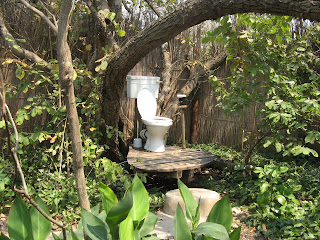 |
 |
 |
The area we are passing through belongs to the Kovango tribe and we note the difference in the design of their houses. Ronney explains that the Kovango are inclined to covet what their neighbours have so their houses are built without windows and surrounded by sticks so no one can see in. The Kovango use oxen to pull their carts, instead of the donkeys used in Demara country. On the outskirts of Rundu we see a lot of litter. It is the first time we have seen any in Namibia, and we also see a large number of squatters in make shift shelters. Rundu is a depressing dusty hell hole with a plethora of bars, even the guide book says there is nothing to recommend it, so we stop, only briefly, for fuel. We continue towards our next camp at Ngepi, driving part of the way along the Caprivi Strip which belongs to Namibia and cuts between Botswana, Angola and Zambia. In 1890 Germany did a deal with the United Kingdom to relinquish its interest in Zanzibar in return for the Caprivi Strip which would then give Germany access to the Zambezi River, a vital trade route. The strip is a curious finger of land wedged between the three other countries. Finally, after ten hours on the road we arrive at our camp at Ngepi. As the sun is setting we bounce and shake down a long sandy track to reach the camp entrance. Approaching the camp gate we are deliberately cut off by a driver in one of the large overland trucks which travel through Africa. He races to claim the best camp site and starts to unload his truck right across the entrance to the camp site we will have to use, setting up cooking tables and blocking our access. We can't get our truck in and he refuses to move so we have to carry our tents, luggage and all the camp equipment a long way to our site. It is hot, tiring work and we are all weary from our long day on the road. We are not happy. The driver of the truck is English and his behaviour confirms something we have noticed. The Europeans who drive trucks in Africa are often loud, boorish, rude and rough and could learn a lot about diplomacy, public relations and just plain good manners from the African safari leaders. I feel quite embarrassed to be European.
 |
Ngepi camp sits on the banks of the Okavango River and is really unusual, funky would be a good way to describe it. It appears to have been designed by hippies with a great sense of humour. All the toilets and showers are walled but roofless. Each has a theme, for example the Garden of Eden toilet is set in a pretty garden and the toilet is on a plinth, like a throne. One toilet block has "Mens" one side and "Ladies" the other but when you go in you find two toilets side by side with no wall between. The ladies has a pink fluffy cover on it and the mens has the toilet seat padlocked up. I don't have the nerve to use these toilets! I use the Garden of Eden toilet and something catches my eye ...a big rat is peering at me from the foliage...eeek! It runs away when I shout at it but I soon see it peeping at me again. The river is home to a large number of hippos and crocodiles. Apparently hippos kill more people in Africa every year than any other animal. I hope they don't come into camp tonight! We have been told not to go to the far end of the camp because we would be in danger. We are all very tired at dinner time but Jonas still manages to cook us a great meal of steak and garlic bread. We are in bed by 10pm and I really enjoy listening to the sounds of the frogs and the bush and the occasional grunting hippo as I drift off to sleep.
 |
Photos: (1) Kovango House, (2) Kovango bullock cart, (3) Kovango village, (4) The Garden of Eden toilet at Ngepi Camp, (5) My filthy feet, it was a constant battle to stay clean! (6) Locals on the river,
(7) Hippo in the Okavango River by our camp


No comments:
Post a Comment